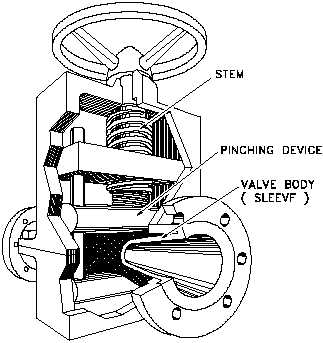TYPES OF VALVES
DOE-HDBK-1018/2-93
Valves
Non-variable reducing valves eliminate the need for the intermediate auxiliary valve found in
variable reducing valves by having the opposing forces react directly on the diaphragm.
Therefore, non-variable reducing valves are more responsive to large pressure variations and are
less susceptible to failure than are variable reducing valves.
Pinch Valves
The relatively inexpensive pinch valve,
Figure 18 Pinch Valves
illustrated in Figure 18, is the simplest
in any valve design. It is simply an
industrial version of the pinch cock
used in the laboratory to control the
flow of fluids through rubber tubing.
Pinch valves are suitable for on-off
and throttling services. However, the
effective throttling range is usually
between 10% and 95% of the rated
flow capacity.
Pinch valves are ideally suited for the
handling of slurries, liquids with large
amounts of suspended solids, and
systems
that
convey
solids
pneumatically. Because the operating
mechanism is completely isolated from
the fluid, these valves also find
application where corrosion or metal
contamination of the fluid might be a
problem.
The pinch control valve consists of a sleeve molded of rubber or other synthetic material and
a pinching mechanism. All of the operating portions are completely external to the valve. The
molded sleeve is referred to as the valve body.
Pinch valve bodies are manufactured of natural and synthetic rubbers and plastics which have
good abrasion resistance properties. These properties permit little damage to the valve sleeve,
thereby providing virtually unimpeded flow. Sleeves are available with either extended hubs and
clamps designed to slip over a pipe end, or with a flanged end having standard dimensions.
ME-04
Rev.0
Page 30

